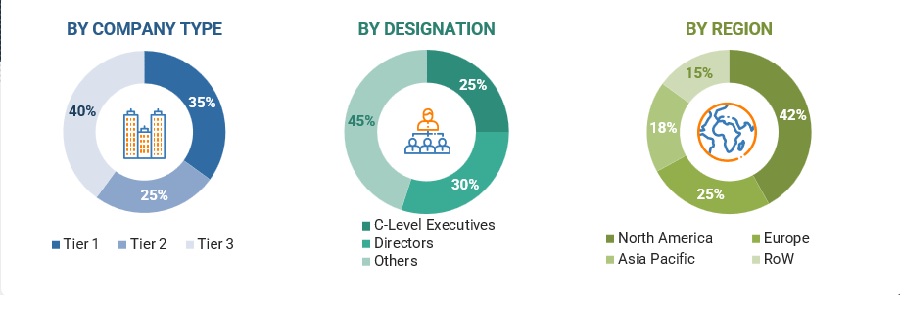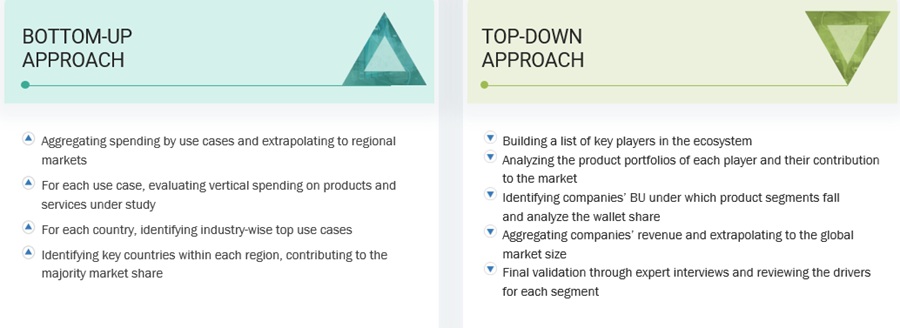The study comprised four main activities to estimate the visual cloud market size. We conducted significant secondary research to gather data on the market, the competing market, and the parent market. The following stage involved conducting primary research to confirm these conclusions and hypotheses and sizing with industry experts throughout the value chain. The overall market size was evaluated using a blend of top-down and bottom-up approach methodologies. After that, we estimated the market sizes of the various visual cloud market segments using the market breakup and data triangulation techniques.
Secondary Research
The size of companies offering visual cloud markets and services was determined based on secondary data from paid and unpaid sources. It was also arrived at by analyzing the product portfolios of major companies and rating the companies based on their performance and quality.
In the secondary research process, various sources were referred to identify and collect information for this study. Secondary sources included annual reports, press releases, and investor presentations of companies; white papers, journals, and certified publications; and articles from recognized authors, directories, and databases. The data was also collected from other secondary sources, such as journals, government websites, blogs, and vendors' websites. Additionally, the spending of various countries on the visual cloud market was extracted from the respective sources. Secondary research was mainly used to obtain the critical information related to the industry's value chain and supply chain to identify the key players based on solutions, services, market classification, and segmentation according to components of the major players, industry trends related to components, users, and regions, and the key developments from both market- and technology-oriented perspectives.
Primary Research
In the primary research process, various primary sources from the supply and demand sides of the visual cloud market were interviewed to obtain qualitative and quantitative information for this study. The primary sources from the supply side included industry experts, such as Chief Executive Officers (CEOs), Vice Presidents (VPs), marketing directors, technology and innovation directors, and related key executives from vendors providing visual cloud offerings, associated service providers; and is operating in the targeted countries. all possible parameters that affect the market covered in this research study have been accounted for, viewed in extensive detail, verified through primary research, and analyzed to arrive at the final quantitative and qualitative data.
After the complete market engineering process (including calculations for market statistics, market breakup, market size estimations, market forecasting, and data triangulation), extensive primary research was conducted to gather information and verify and validate the critical numbers arrived at. The primary research also helped identify and validate the segmentation, industry trends, key players, competitive landscape, and market dynamics, such as drivers, restraints, opportunities, challenges, and key strategies. In the complete market engineering process, the bottom-up approach and several data triangulation methods were extensively used to perform market estimation and market forecasting for the overall market segments and subsegments listed in this report. An extensive qualitative and quantitative analysis of the complete market engineering process was performed to list the key information/insights throughout the report.

To know about the assumptions considered for the study, download the pdf brochure
Market Size Estimation
The visual cloud market and related submarkets were estimated and forecasted using top-down and bottom-up methodologies. The bottom-up method was used to determine the market's overall size, using the revenues and product offerings of the major market players. This research ascertained and validated the precise value of the total parent market size through data triangulation techniques and primary interview validation. Next, using percentage splits of the market segments, the overall market size was utilized in the top-down approach to estimate the size of other individual markets.
Top Down and Bottom Up Approach of Visual Cloud Market.

To know about the assumptions considered for the study, Request for Free Sample Report
The research methodology used to estimate the market size included the following:
-
Primary and secondary research was utilized to determine the revenue contributions of the major market participants in each country after secondary research helped identify them.
-
Throughout the process, critical insights were obtained by conducting in-depth interviews with industry professionals, including directors, CEOs, VPs, and marketing executives, and by reading the annual and financial reports of the top firms in the market.
-
Primary sources were used to verify all percentage splits and breakups, which were calculated using secondary sources.
Data Triangulation
The market was divided into several segments and subsegments using the previously described market size estimation procedures once the overall market size was determined. When required, market breakdown and data triangulation procedures were employed to complete the market engineering process and specify the exact figures for every market segment and subsegment. The data was triangulated by examining several variables and patterns from government entities' supply and demand sides.
Market Definition
MarketsandMarkets defines visual cloud as a cloud computing sector focused on delivering and processing visual content such as images, videos, and graphics-intensive applications. These services leverage robust cloud infrastructure to handle tasks such as rendering, video encoding, and real-time streaming, enabling high-quality visual experiences over the Internet. Visual cloud solutions are essential for industries such as media and entertainment, gaming, virtual and augmented reality, and remote work, providing scalable and efficient resources without significant local hardware investments. They support applications ranging from video conferencing and virtual desktops to advanced data visualization and cloud gaming.
Key Stakeholders
-
Training and consulting service providers
-
Information Technology (IT) infrastructure providers
-
Visual cloud solutions providers
-
Visual cloud service providers
-
Government organizations and standardization bodies
-
Regional associations
-
Value-added resellers and distributors
Report Objectives
-
To define, describe, and forecast the visual cloud market based on offering, service model, organization size, deployment mode, vertical, and region.
-
To provide detailed information about the significant factors, such as drivers, opportunities, restraints, and challenges, influencing the growth of the market
-
To analyze the opportunities in the market for stakeholders by identifying the high-growth segments of the market
-
To forecast the market size concerning five main regions — North America, Europe, Asia Pacific, the Middle East & Africa, and Latin America
-
To analyze the subsegments of the market concerning individual growth trends, prospects, and contributions to the overall market
-
To profile the market's key players and analyze their size and core competencies comprehensively.
-
To track and analyze the competitive developments, such as product enhancements, product launches, acquisitions, partnerships, and collaborations, in the visual cloud market globally
Available customizations
MarketsandMarkets provides customizations based on the company's unique requirements using market data. The following customization options are available for the report:
Product analysis
-
The product matrix provides a detailed comparison of each company's product portfolio.
Geographic analysis
-
Further breakup of the visual cloud market
Company information
-
Detailed analysis and profiling of five additional market players



Growth opportunities and latent adjacency in Visual Cloud Market